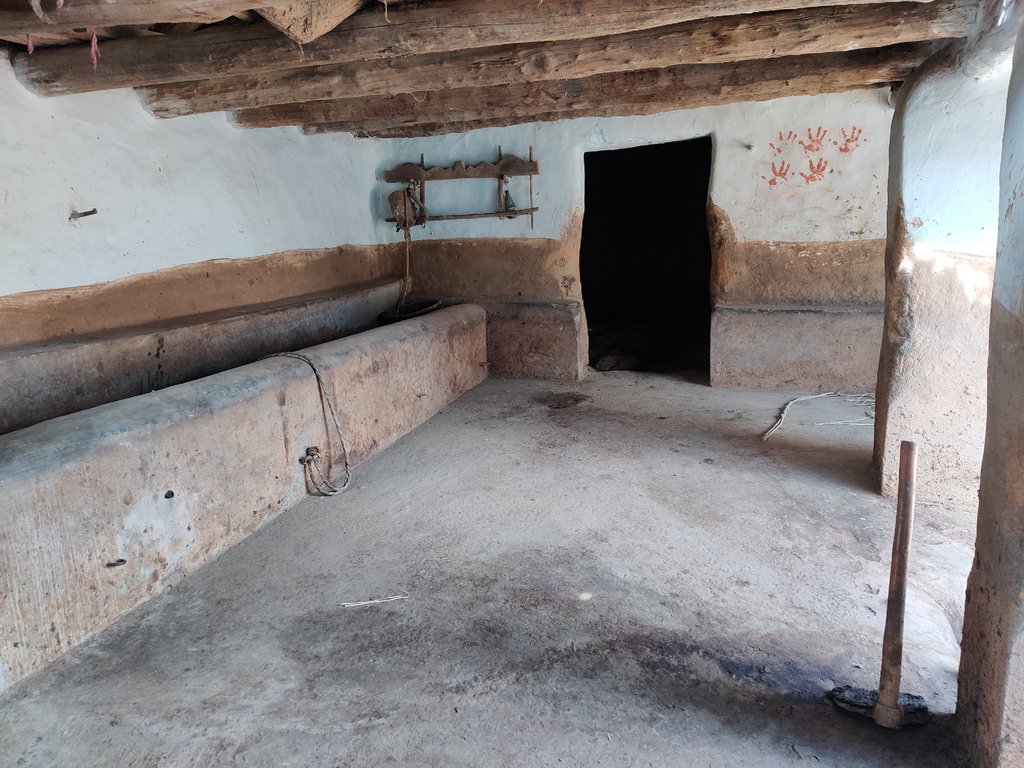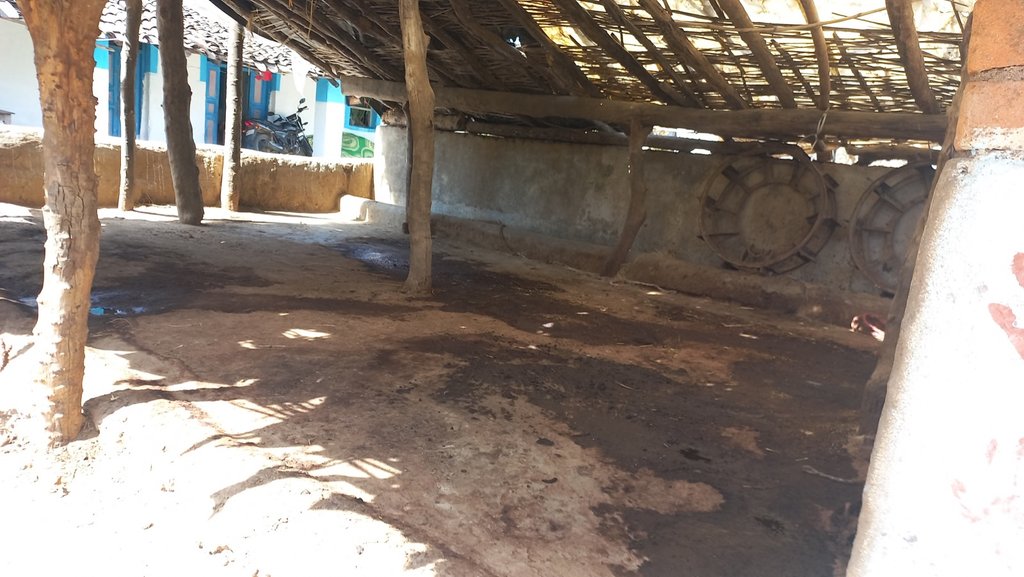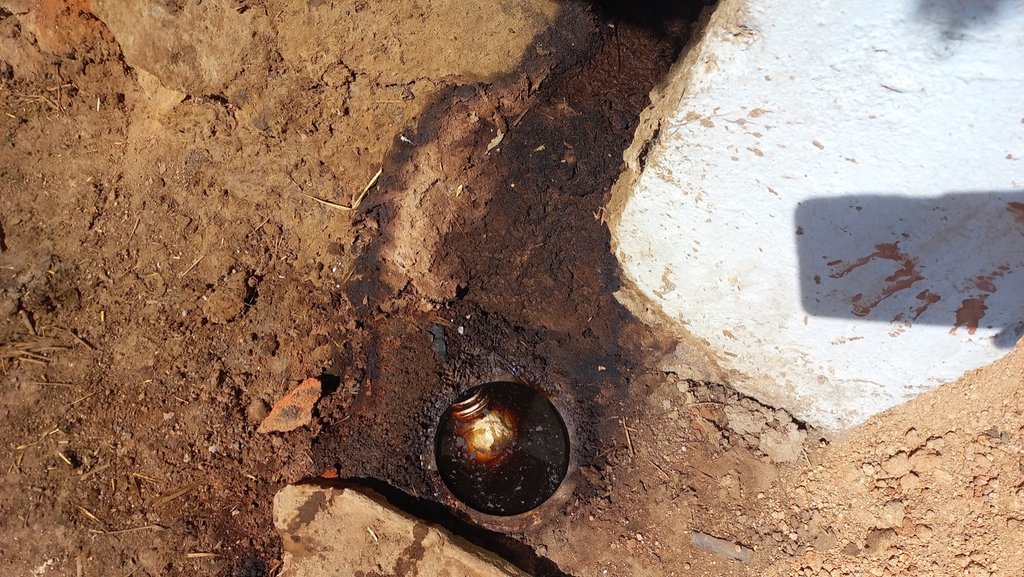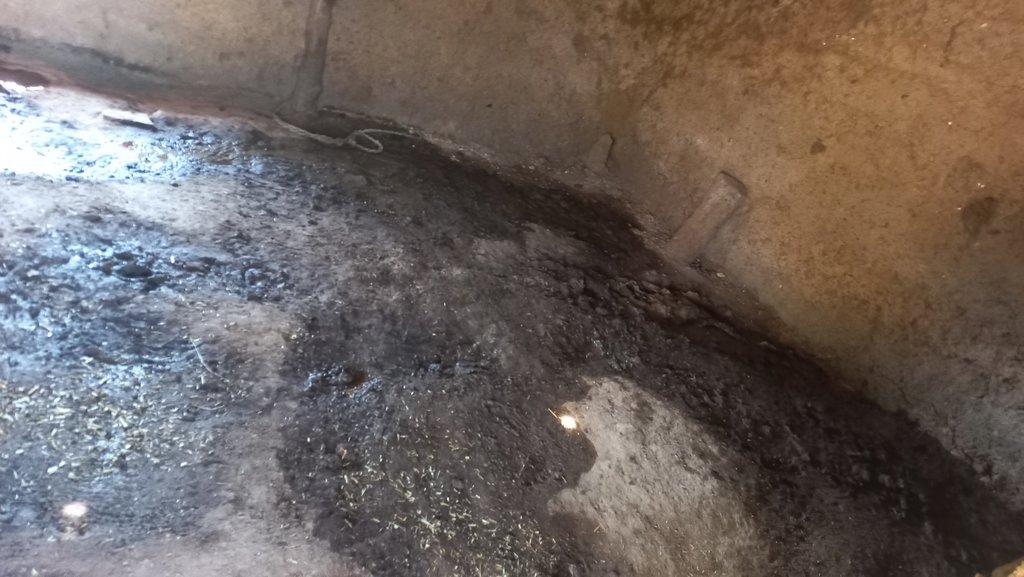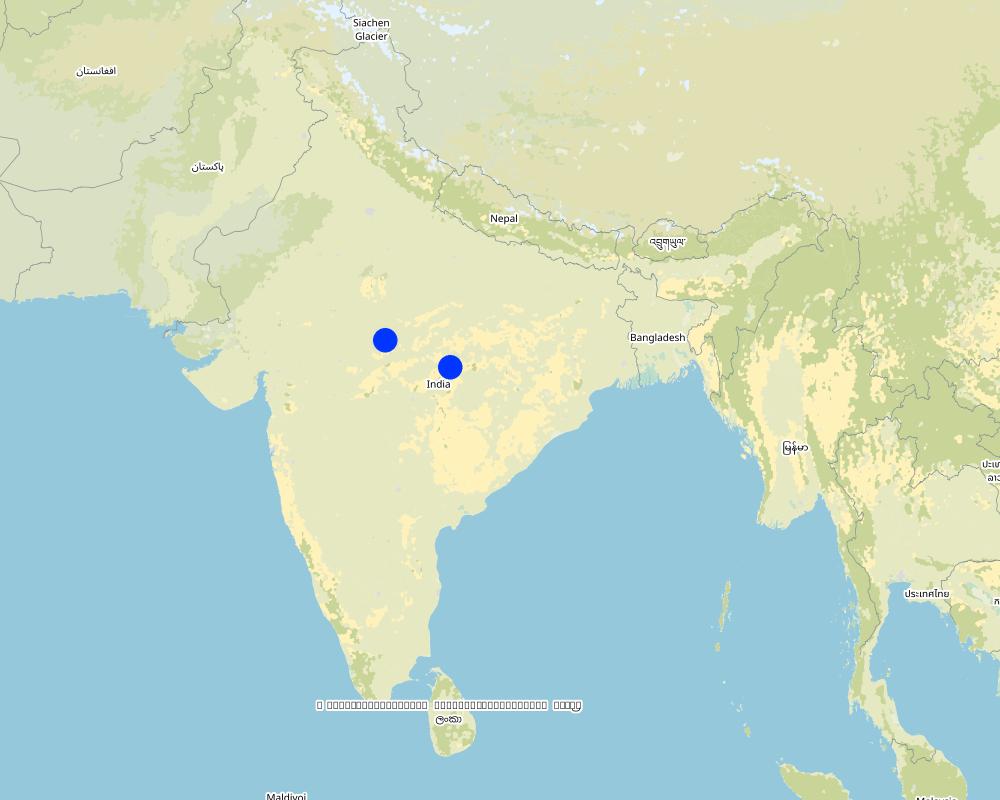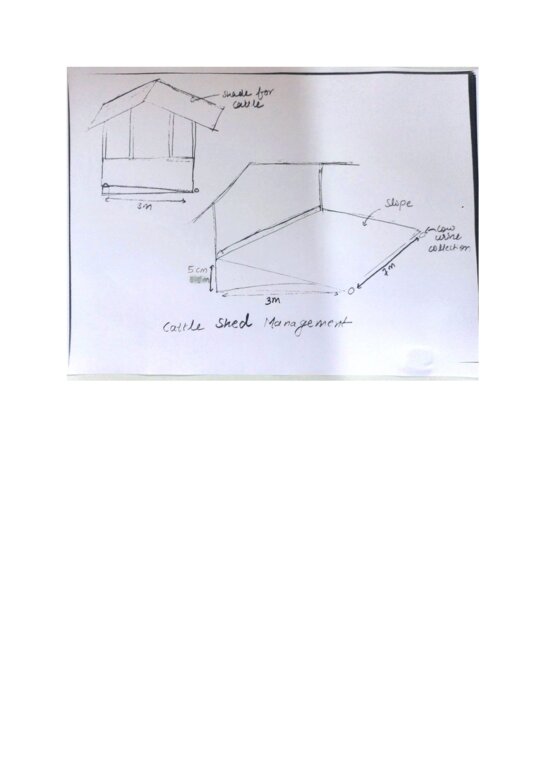Improved Cattle Shed Flooring for Conservation of Cow Dung and Urine for Biofertilizer Production at Farm Level [India]
- Creación:
- Actualización:
- Compilador: Santosh Gupta
- Editores: Noel Templer, Stephanie Katsir, Kim Arora
- Revisor: Udo Höggel
technologies_6721 - India
- Resumen completo en PDF
- Resumen completo en PDF para imprimir
- Resumen completo en el navegador
- Resumen completo (sin formato)
- Improved Cattle Shed Flooring for Conservation of Cow Dung and Urine for Biofertilizer Production at Farm Level: 25 de junio de 2023 (inactive)
- Improved Cattle Shed Flooring for Conservation of Cow Dung and Urine for Biofertilizer Production at Farm Level: 14 de septiembre de 2023 (inactive)
- Improved Cattle Shed Flooring for Conservation of Cow Dung and Urine for Biofertilizer Production at Farm Level: 11 de abril de 2024 (public)
Visualizar secciones
Expandir todo Colapsar todos1. Información general
1.2 Detalles de contacto de las personas de referencia e instituciones involucradas en la evaluación y la documentación de la Tecnología
Nombre de la(s) institución(es) que facilitaron la documentación/ evaluación de la Tecnología (si fuera relevante)
Deutsche Gesellschaft für Internationale Zusammenarbeit (GIZ) GmbH (GIZ) - AlemaniaNombre de la(s) institución(es) que facilitaron la documentación/ evaluación de la Tecnología (si fuera relevante)
Alliance Bioversity and International Center for Tropical Agriculture (Alliance Bioversity-CIAT) - KeniaNombre de la(s) institución(es) que facilitaron la documentación/ evaluación de la Tecnología (si fuera relevante)
Ecociate Consultants (Ecociate Consultants) - India1.3 Condiciones referidas al uso de datos documentados mediante WOCAT
El compilador y la/s persona(s) de referencia claves aceptan las condiciones acerca del uso de los datos documentados mediante WOCAT:
Sí
1.4 Declaración de la sostenibilidad de la Tecnología descrita
¿La Tecnología aquí descrita resulta problemática en relación a la degradación de la tierra, de tal forma que no puede considerársela una tecnología sostenible para el manejo de la tierra?
No
2. Descripción de la Tecnología MST
2.1 Breve descripción de la Tecnología
Definición de la Tecnología:
In the cattle shed management system, the cattle shed should be constructed with an elevated concrete floor that slopes slightly toward a cow urine collection point. The collection point should be equipped with a drainage system to easily remove cow dung and urine.
An elevated concrete floor for cow dung and urine collection can improve hygiene, and waste management, and reduce labour costs in cattle sheds. Collected cow urine and cow dung can be used to prepare biological inputs and compost for nutrient and pest management in agriculture.
2.2 Descripción detallada de la Tecnología
Descripción:
Cattle shed management technology, including the use of a concrete elevated floor for cow dung and urine collection, is a cost-effective and efficient technology to support the natural farming system. This technology can be applied in both natural and human environments. In natural environments, such as rural or agricultural areas, cattle sheds are typically used for dairy and farmyard manure production. The use of this technology can improve the hygiene of cattle and their environment, reduce waste and pollution, and promote the sustainable use of natural resources. The cow dung and urine so collected can be used as fertilizer to improve soil quality, and the improved hygiene of the cattle can reduce the risk of diseases spreading to other animals or humans. The use of this technology can help to reduce the negative impacts of cattle farming on the surrounding environment, such as odours and pollution. It can also improve the hygiene of the cattle and their environment, which is important for both animal welfare and public health.
Traditionally farmers were constructing the floors of cattle sheds using mud and soil. These floors absorb the cow urine and the movement of animals also makes holes in it because of that cow urine and cow dung are used to get filled in these halls. Which made the entire floor unhygienic for both animals and farmers. Because of such surfaces, it was very hard to clean these sheds. The use of an elevated floor made with cement-concrete and a waste management system can help to keep the cattle shed clean and dry, which can reduce the risk of disease and infection among the animals. The collection and disposal of cow dung and urine can help preventing environmental pollution, reducing the negative impacts of cattle farming on the surrounding area, and promoting sustainable use of natural resources. The use of a concrete elevated floor can make cleaning the cattle shed faster and easier, reducing labour costs and improving the efficiency of the farming operation.
Technical specifications for the construction of cattle sheds can vary depending on factors such as the size of the herd, local environmental regulations, and available resources. However, in general, the main characteristics and elements of cattle shed management technology are designed to promote animal welfare, hygiene, waste management, and sustainability. Proper cattle shed management technology can provide a comfortable and safe environment for the animals, which can reduce stress and promote animal welfare. Proper waste management and ventilation can help to minimize unpleasant odours from the cattle shed, which thus reduces negative impacts on the surrounding community.
Establishing and maintaining cattle shed management technology requires a combination of technical expertise, labour, and resources. By investing in these inputs, farmers can promote sustainable and efficient cattle farming practices and improve the health and welfare of their animals.
The collected cow urine and cow dung are the main resources for preparing the biological inputs and different types of compost for meeting the nutritional requirement of crops while also addressing the challenges of pest and disease management in a natural or organic farming system. The improved flooring of cow shed units has been a great intervention to replace and reduce the usage of synthetic fertilisers and pesticides in the project region.
The views of land users, such as farmers or livestock keepers, about cattle shed management technology, including the use of a concrete elevated floor for cow dung and urine collection, can vary depending on their experiences and perceptions. The interviewed land user liked or appreciated, cattle shed management for improving animal health and productivity, increasing farm profitability, cleaning the cattle shed easier and faster, reducing labour costs, improving efficiency, and for environmental benefits.
2.3 Fotografías de la Tecnología
Comentarios generales sobre las fotos:
All of these phots have been taken with the consent of participants.
2.4 Videos de la Tecnología
Comentarios, descripción breve:
https://youtube.com/watch?v=Gd6u8yZ9DqY&si=EnSIkaIECMiOmarE
Fecha:
01/02/2021
Lugar:
Mandla, Madhya Pradesh, India
Nombre del videógrafo:
Soil Matters
2.5 País/ región/ lugares donde la Tecnología fue aplicada y que se hallan comprendidos por esta evaluación
País:
India
Región/ Estado/ Provincia:
Madhya Pradesh
Especifique más el lugar :
Mandla District
Especifique la difusión de la Tecnología:
- aplicada en puntos específicos/ concentrada en un área pequeña
¿El/los sitio(s) de la Tecnología se ubica(n) en un área de protección permanente?
No
Comentarios:
The technology is being adopted by more than 100 farmers across the 10-15 villages of the Bichhiya block in Mandla District of Madhya Pradesh
Map
×2.6 Fecha de la implementación
Si no se conoce el año preciso, indique la fecha aproximada:
- hace menos de 10 años (recientemente)
2.7 Introducción de la Tecnología
Especifique cómo se introdujo la Tecnología:
- mediante proyectos/ intervenciones externas
Comentarios (tipo de proyecto, etc.):
Initially, the project supported the farmers in the construction of cemented cow shed floors in a limited area. However, there has also been investment from the users either by putting extra funds to extend the area or by contributing labour.
3. Clasificación de la Tecnología MST
3.1 Propósito(s) principal(es) de la Tecnología MST
- mejorar la producción
- reducir, prevenir, restaurar la degradación de la tierra
- conservar el ecosistema
- crear impacto económico benéfico
- Control cattle diseases
3.2 Tipo(s) actuales de uso de la tierra donde se aplica la Tecnología
Mezcla de tipos de uso de tierras dentro de la misma unidad de tierras: :
No

Tierras cultivadas
- Cosecha anual
Cosechas anuales - Especifique cultivos:
- cereales - maíz
- cereales - arroz (humedal)
- cereales - trigo (invierno)
- legumes and pulses - lentils
- cultivos de semillas oleaginosas - girasol, colza, otros
- vegetales - verdura de hojas verdes (ensaladas, repollo, espinaca, otros)
Número de temporadas de cultivo por año:
- 2
Especifique:
In kharif (summer) season farmers are sowing paddy in wetlands and in rabi (winter) season wheat, chickpea, mustard, maize and other vegetables
¿Se practica el intercultivo?
Sí
Si respondió que sí, especifique qué cultivos son intercultivados:
Chickpea intercropping with beans, mixed cropping system of vegetables present
¿Se practica la rotación de cultivos?
Sí
Si fuera el caso, especifique :
Rice- Chickpea
Rice-Wheat
Rice- Maize
Comentarios:
The intervention is mostly focused on improved cattle shed units. However, collected cow urine and cow dung are good for restoring the degraded agricultural land.
3.3 ¿Cambió el uso de tierras debido a la implementación de la Tecnología?
¿Cambió el uso de tierras debido a la implementación de la Tecnología?
- No (Continúe con la pregunta 3.4)
3.4 Provisión de agua
Provisión de agua para la tierra donde se aplica la Tecnología:
- mixta de secano – irrigada
Comentarios:
For irrigation, most of the farmers were dependent upon rain in the Kharif and Rabi season. Some of the farmers were using additional irrigation during critical crop stages by using water canals.
3.5 Grupo MST al que pertenece la Tecnología
- manejo de agricultura—ganadería integrada
- manejo integrado de la fertilidad del suelo
3.6 Medidas MST que componen la Tecnología

medidas agronómicas
- A2: materia orgánica/ fertilidad del suelo
- A6: Manejo de residuos
A6: Especifique manejo de residuos:
A 6.4: retenido

medidas estructurales
- S9: Refugios para plantas y animales

medidas de manejo
- M6: Manejo de desperdicios (reciclado, reutilización o reducción)
Comentarios:
The implemented technology led to the management and use of waste for productive purposes. While it has improved the productivity of animals by reducing the occurrence of diseases, it has also enabled the preparation of organic inputs to replace the synthetic fertilisers in farming.
3.7 Principales tipos de degradación de la tierra encarados con la Tecnología

deterioro químico del suelo
- Cn: reducción de la fertilidad y contenido reducido de la materia orgánica del suelo (no ocasionados por la erosión)

degradación biológica
- Bp: incremento de pestes/ enfermedades, pérdida de depredadores

degradación del agua
- Hq: reducción de la calidad de subterráneas
- Hq: reducción de la calidad de aguas subterráneas
Comentarios:
Proper collection of cow dung and cow urine minimised run-off these substance and mixing with surface water used for various purposes including drinking water.
3.8 Prevención, reducción o restauración de la degradación de la tierra
Especifique la meta de la Tecnología con relación a la degradación de la tierra:
- prevenir la degradación de la tierra
- reducir la degradación de la tierra
Comentarios:
Application of cow urine and cow dung in soil by mixing with other organic matters improves the soil health and also reduces the dependency on synthetic fertilisers and pesticides
4. Especificaciones técnicas, actividades de implementación, insumos y costos
4.1 Dibujo técnico de la Tecnología
Especificaciones técnicas (relacionadas al dibujo técnico):
Dimensions of the cowshed (depending on the number of cows kept):
Length: 7m
Width: 3m
Elevated: 5 cm (means in effect the slope: i.e. the front floor of the cowshed is 5 cm higher than the floor at the end, where dung and urine get collected)
Autor:
Payal Dewangan
Fecha:
22/02/2023
4.2 Información general sobre el cálculo de insumos y costos
Especifique cómo se calcularon los costos e insumos:
- por unidad de Tecnología
Especifique unidad:
one cattle shed
Especifique las dimensiones de la unidad (si fuera relevante):
meter
otra / moneda nacional (especifique):
Indian Rupee
Si fuera relevante, indique la tasa de cambio de dólares americanos a la moneda local (ej. 1 U$ = 79.9 Reales Brasileros): 1 U$ =:
82,24
Indique el costo promedio del salario de trabajo contratado por día:
240
4.3 Actividades de establecimiento
| Actividad | Momento (estación) | |
|---|---|---|
| 1. | Concrete floor construction for cattle shed | March |
| 2. | Cattle shed roof development | April |
4.4 Costos e insumos necesarios para el establecimiento
Si no puede desglosar los costos especificados en la tabla anterior, proporcione un estimado de los cálculos totales en los que se incurrió para establecer la Tecnología:
28000,0
Si el usuario de la tierra no cubrió el 100% de los costos, indique quién financió el resto del costo:
Gram Paryavaran Samiti and Prakritik Sansadhan Prabhandhan Samiti
Comentarios:
Village groups were formed for the implementation of the technology
4.5 Actividades de establecimiento/ recurrentes
| Actividad | Momento/ frequencia | |
|---|---|---|
| 1. | Cleaning of concrete floor | Once in a day |
| 2. | Collection of cow dung | Once in a day |
| 3. | collection of cow urine from the pit or drum | Twice in a week |
| 4. | Fodder and drinking water provision | Twice in a day |
4.7 Factores más determinantes que afectan los costos:
Describa los factores más determinantes que afectan los costos:
Design and technical specifications: The cost of the technology can vary depending on the design and technical specifications of the cattle shed, including the size and materials used.
Construction materials and labor costs: The cost of construction materials and labor can vary depending on local market conditions and availability.
Location: The cost of transporting materials and labor to the construction site can vary depending on the location of the farm.
Maintenance and repair costs: The cost of maintaining and repairing the cattle shed can also add to the overall cost of the technology.
Training and capacity building: Providing training and capacity building to farmers and workers on proper cattle shed management techniques can add to the overall cost of the technology.
5. Entorno natural y humano
5.1 Clima
Lluvia anual
- < 250 mm
- 251-500 mm
- 501-750 mm
- 751-1,000 mm
- 1,001-1,500 mm
- 1,501-2,000 mm
- 2,001-3,000 mm
- 3,001-4,000 mm
- > 4,000 mm
Especifique el promedio anual de lluvia (si lo conoce), en mm:
1427,00
Especificaciones/ comentarios sobre la cantidad de lluvia:
Highest rainfall occurs between June to September.
Indique el nombre de la estación metereológica de referencia considerada:
Mandla, Madhya Pradesh
Zona agroclimática
- semi-árida
The climate of the District is tropical, with moderate winters, severe summers, and well-distributed rainfall received from the southwest monsoon. However, due to higher general elevation and abundance of forests, summer temperatures do not rise as much as in other areas.
5.2 Topografía
Pendientes en promedio:
- plana (0-2 %)
- ligera (3-5%)
- moderada (6-10%)
- ondulada (11-15%)
- accidentada (16-30%)
- empinada (31-60%)
- muy empinada (>60%)
Formaciones telúricas:
- meseta/ planicies
- cordilleras
- laderas montañosas
- laderas de cerro
- pies de monte
- fondo del valle
Zona altitudinal:
- 0-100 m s.n.m.
- 101-500 m s.n.m.
- 501-1,000 m s.n.m
- 1,001-1,500 m s.n.m
- 1,501-2,000 m s.n.m
- 2,001-2,500 m s.n.m
- 2,501-3,000 m s.n.m
- 3,001-4,000 m s.n.m
- > 4,000 m s.n.m
Indique si la Tecnología se aplica específicamente en:
- no relevante
Comentarios y especificaciones adicionales sobre topografía :
The topography of the project area consists of a hilly area and a forest area. Mandla District is hilly and forested (Satpura hill range) and highly undulating with a narrow strip of cultivated plains in the valley portion of the river. The plateau is in the northern part formed by basalt, and east-west trending hills in the southern part. The highest elevation is 934 m amsl in the northern part, and the lowest is around 400 m amsl in the northwestern part of the area. The elevation of the studied block Bichhiya is 453 m amsl.
Source: District at a Glance; Ministry of Water Resources, Government of Madhya Pradesh
5.3 Suelos
Profundidad promedio del suelo:
- muy superficial (0-20 cm)
- superficial (21-50 cm)
- moderadamente profunda (51-80 cm)
- profunda (81-120 cm)
- muy profunda (>120 cm)
Textura del suelo (capa arable):
- áspera/ ligera (arenosa)
- mediana (limosa)
Textura del suelo (> 20 cm debajo de la superficie):
- mediana (limosa)
Materia orgánica de capa arable:
- baja (<1%)
Si se halla disponible, adjunte una descripción completa de los suelos o especifique la información disponible, por ej., tipo de suelo, pH/ acidez de suelo, capacidad de intercambio catiónico, nitrógeno, salinidad, etc. :
Soil Testing Parameter status (Average) 2017-20 for the project areas is as follows. This data is based on the soil samples tested by the FES in its soil labs from the project villages.
Sail pH:-5.906548628; EC (electrical conductivity): 0.122993577: Soil Organic Carbon: 0:83%; Nitrogen:- 293.3696598; Phosphorus:- 25.77762582; Potassium (K):- 139.6696636: Sulphur
(S)-18.93457993; Zinc (Zn):-0.955246706; Boron (Bn):-0.490850376
5.4 Disponibilidad y calidad de agua
Agua subterránea:
> 50 m
Disponibilidad de aguas superficiales:
mediana
Calidad de agua (sin tratar):
agua potable de mala calidad (requiere tratamiento)
La calidad de agua se refiere a:
agua subterránea y superficial
¿La salinidad del agua es un problema?
No
¿Se está llevando a cabo la inundación del área? :
No
Comentarios y especificaciones adicionales sobre calidad y cantidad de agua:
The groundwater status is within the safe limits as per the reports by the Government of Madhya Pradesh. People use water from rivers, streams, and traditional small wells for domestic purposes. In the absence of good vegetative cover, the rainwater washes off the fertile topsoil from the farmlands making the land barren and resulting in the siltation of ponds and other water bodies. Further, a heavy infestation of invasive species such as Lantana Camara compounds the degradation.
The studied block Bichhiya is in a better position in terms of stage of groundwater development with 17%, stage of groundwater development refers to the % of groundwater being used for various purposes from the available groundwater in that area e.g. net annual groundwater availability in Bichhiya block is 9087 ham (hectare meters) while the existing annual groundwater draft for all usage is 1523 ham, making it a 17% groundwater development stage, while the district average is 79%.
Source: http://cgwb.gov.in/District Profile/MP/Mandla.pdf
5.5 Biodiversidad
Diversidad de especies:
- elevada
Diversidad de hábitats:
- elevada
Comentarios y especificaciones adicionales sobre biodiversidad:
The cattle shed management unit or center is present nearby the forest area of Kanha National Park. There is high biodiversity present in the technology implementation area. Ecological assessment report in Mandla (where this Technology is applied) showed improved biodiversity on common lands under village governance compared to open-access or commons under government ownership. On average, the Shannon Diversity Index of managed common lands was 1.45 compared to 0.42 for the open access of ungoverned commons. Most of the sites under open access lands are infested by Lantana Camara, which is the main reason for the lower biomass and diversity of the ungoverned lands.
5.6 Las características de los usuarios de la tierra que aplican la Tecnología
Sedentario o nómada:
- Sedentario
Orientación del mercado del sistema de producción:
- mixta (subsistencia/ comercial)
Ingresos no agrarios:
- > 50% de todo el ingreso
Nivel relativo de riqueza:
- pobre
Individuos o grupos:
- grupos/ comunal
Nivel de mecanización:
- trabajo manual
- tracción animal
Género:
- mujeres
- hombres
Edad de los usuarios de la tierra:
- jóvenes
- personas de mediana edad
5.7 Área promedio de la tierra usada por usuarios de tierra que aplican la Tecnología
- < 0.5 ha
- 0.5-1 ha
- 1-2 ha
- 2-5 ha
- 5-15 ha
- 15-50 ha
- 50-100 ha
- 100-500 ha
- 500-1,000 ha
- 1,000-10,000 ha
- > 10,000 ha
¿Esto se considera de pequeña, mediana o gran escala (refiriéndose al contexto local)?
- pequeña escala
5.8 Tenencia de tierra, uso de tierra y derechos de uso de agua
Tenencia de tierra:
- individual, con título
Derechos de uso de tierra:
- individual
Derechos de uso de agua:
- comunitarios (organizado)
- individual
¿Los derechos del uso de la tierra se basan en un sistema legal tradicional?
Sí
Especifique:
Some of the land parcels are ancestral land units while some have been transferred into private ownership by the State Government over the years
5.9 Acceso a servicios e infraestructura
salud:
- pobre
- moderado
- bueno
educación:
- pobre
- moderado
- bueno
asistencia técnica:
- pobre
- moderado
- bueno
empleo (ej. fuera de la granja):
- pobre
- moderado
- bueno
mercados:
- pobre
- moderado
- bueno
energía:
- pobre
- moderado
- bueno
caminos y transporte:
- pobre
- moderado
- bueno
agua potable y saneamiento:
- pobre
- moderado
- bueno
servicios financieros:
- pobre
- moderado
- bueno
6. Impactos y comentarios para concluir
6.1 Impactos in situ demostrados por la Tecnología
Impactos socioeconómicos
Producción
producción de cultivo
Comentarios/ especifique:
It was observed and noted from the field site that instead of using chemicals, the application of cow urine and cow dung in the form of farm yard manure has helped in improved production as it led to the reduction of pest infestation and better nutrient uptake from the soil.
calidad de cultivo
Comentarios/ especifique:
Reduction in the use of chemicals in the field and application of collected cow urine and other bioresource products made from cow dung helped in improving the quality of crop in terms of harder crops, good weight of grain, test etc.
producción animal
Comentarios/ especifique:
The improved cattle shed played a crucial role in maintaining the hygiene of animal sheds, which led to the lesser occurrence of disease among animals. Also, the stress level of animals due to the presence of insects and flies reduced significantly. A combination of all these factors improved the milk yield.
riesgo de fracaso de producción
Comentarios/ especifique:
Using sustainable methods for crop production by application of bio inputs not only helps in increasing soil fertility but also contributes to increasing crop resistance, pest control, and better crop development.
diversidad de producto
Ingreso y costos
gastos en insumos agrícolas
Comentarios/ especifique:
Reduced to some extent as now farmers can make their own bio-inputs using the cow urine and cow dung collected from the cattle shed
ingreso agrario
Comentarios/ especifique:
A combination of improved productivity, reduced cost towards agriculture inputs and better milk productivity has helped farmers in improving their income.
diversidad de fuentes de ingreso
Comentarios/ especifique:
Some of the farmers have initiated their own bio resource centres to sell cow urine and cow dung-based bio-inputs, vermicompost etc.
carga de trabajo
Comentarios/ especifique:
The workload of women members in the household was reduced very significantly due to covering the mud-based cow floor with cement-concrete-based cow floor, earlier cleaning of the cow dung and cow urine used to take a lot of the time. However with new floor, it can be cleaned in less than 5 minutes saving almost an hour in a day.
Impactos socioculturales
seguridad alimentaria/ autosuficiencia
situación de salud
Comentarios/ especifique:
Improved hygiene is good for both animal and human health
oportunidades culturales
instituciones comunitarias
Impactos ecológicos
Suelo
humedad del suelo
Comentarios/ especifique:
Application of cow dung, compost and other bio-inputs have improved the soil moisture
ciclo/ recarga de nutrientes
Comentarios/ especifique:
Application of cow dung, compost and other bio-inputs will help in improving the nutrient cycling in the soil and will enhance the soil microbial activities
Reducción de riesgos de desastres y riesgos climáticos
emisión de carbono y gases de invernadero
Comentarios/ especifique:
Some of the farmers are using the collected cow dung as an input for their 'Bio-gas' plants. Thus, the use of biogas plants not only reduces the use of fire wood and LPG for cooking but its waste (slurry) is also used as inputs for agriculture fields. Thus reducing the overall footprint of GHG emission.
6.2 Impactos fuera del sitio demostrados por la Tecnología
daño a campos de vecinos
impacto de gases de invernadero
Comentarios/ especifique:
Some of the farmers have installed bio gas plants. Use of biogas plants not only reduces the use of fire wood and LPG for cooking but its waste (slurry) is also used as inputs for Some of the farmers are using the collected cow dung as an input for their 'Bio-gas' plants agriculture fields. Thus reducing the overall footprint of GHG emission.
Also the improved floor have helped in proper collection of cow dung and cow urine for the purpose of composting. Composting makes the compounds in manure more stable and therefore reduces the amount that is released into the atmosphere.
6.3 Exposición y sensibilidad de la Tecnología al cambio climático gradual y a extremos relacionados al clima/ desastres (desde la percepción de los usuarios de tierras)
Cambio climático gradual
Cambio climático gradual
| Estación | Incremento o reducción | ¿Cómo es que la tecnología soporta esto? | |
|---|---|---|---|
| temperatura anual | incrementó | muy bien |
6.4 Análisis costo-beneficio
¿Cómo se comparan los beneficios con los costos de establecimiento (desde la perspectiva de los usuarios de tierra)?
Ingresos a corto plazo:
negativo
Ingresos a largo plazo:
positivo
¿Cómo se comparan los beneficios con los costos de mantenimiento/ recurrentes (desde la perspectiva de los usuarios de tierra)?
Ingresos a corto plazo:
ligeramente negativo
Ingresos a largo plazo:
muy positivo
Comentarios:
Low maintenance cost compared with benefits of higher animal productivity and hygienic living
6.5 Adopción de la Tecnología
- 1-10%
De todos quienes adoptaron la Tecnología, ¿cuántos lo hicieron espontáneamente, por ej. sin recibir nada de incentivos/ materiales:
- 0-10%
6.6 Adaptación
¿La tecnología fue modificada recientemente para adaptarse a las condiciones cambiantes?
No
6.7 Fuerzas/ ventajas/ oportunidades de la Tecnología
| Fuerzas/ ventajas/ oportunidades desde la perspectiva del usuario de la tierra |
|---|
| Reduced labour of urine and dung collection |
| Better animal management |
| Fuerzas/ ventajas/ oportunidades desde la perspectiva del compilador o de otra persona de referencia clave |
|---|
| Reduced GHG emission because of better handling of dung and urine |
| Increased productivity because of the use of animal manure |
6.8 Debilidades/ desventajas/ riesgos de la Tecnología y formas de sobreponerse a ellos
| Debilidades/ desventajas/ riesgos desde la perspectiva del usuario de la tierra | ¿Cómo sobreponerse a ellas? |
|---|---|
| High establishment cost | Subsidies and grants |
| Regular maintenance cost | Technological innovation |
| Debilidades/ desventajas/ riesgos desde la perspectiva del compilador o de otra persona de referencia clave | ¿Cómo sobreponerse a ellas? |
|---|---|
| Possibilities of disadoption because of maintenance cost | Increase returns of the units by extending new products from Urine and dung |
| No demand | Increase communication and extension on the benefits of different products from animals |
7. Referencias y vínculos
7.1 Métodos/ fuentes de información
- entrevistas con usuarios de tierras
7.2 Vínculos a las publicaciones disponibles
Título, autor, año, ISBN:
Repairing cattle shed floor
¿Dónde se halla disponible? ¿Costo?
Foundation for Ecological Security, Mandla, MP, India
7.3 Vínculos a la información relevante disponible en línea
Título/ descripción:
Cattle sheds: one intervention, several benefits for farmers
URL:
https://www.youtube.com/watch?v=Gd6u8yZ9DqY
Vínculos y módulos
Expandir todo Colapsar todosVínculos
No hay vínculos
Módulos
No se hallaron módulos



